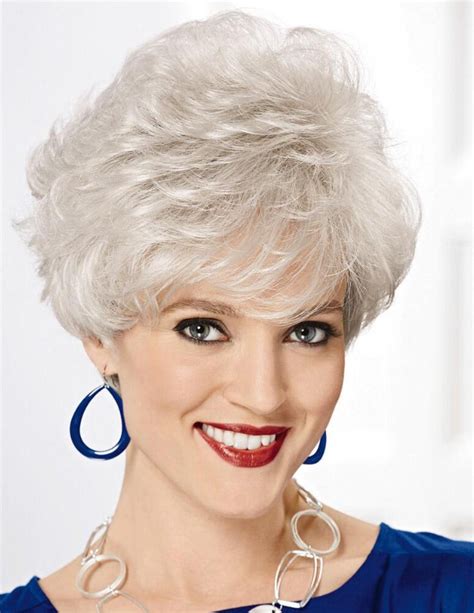As we age, our hair may start to thin, gray, or even fall out. This can be a significant blow to our confidence, as our hair is often a big part of our identity. However, there is a solution that can help us maintain our youthful appearance and feel confident again: wigs.

Choosing the Right Wig
Wigs are available in a wide variety of styles, colors, and sizes. It is important to choose a wig that is not only the right color and style for you, but also fits well. A wig that is too tight will be uncomfortable and may cause headaches. A wig that is too loose will slip around and may not stay in place.
When choosing a wig, it is important to consider your lifestyle. If you are active, you will need a wig that is made of lightweight, durable materials. If you have sensitive skin, you will need a wig made of hypoallergenic materials.
Different Types of Wigs
There are several different types of wigs available, each with its own unique advantages and disadvantages.
- Synthetic wigs are made from man-made fibers, such as acrylic or nylon. They are generally less expensive than human hair wigs, and they are more durable. However, synthetic wigs can be less breathable than human hair wigs, and they may not be as comfortable to wear.
- Human hair wigs are made from real human hair. They are the most natural-looking wigs, and they are more comfortable to wear than synthetic wigs. However, human hair wigs are also more expensive than synthetic wigs, and they require more care.
Average cost: $100-$2,000
Benefits of Wearing a Wig
There are many benefits to wearing a wig, especially for elderly women.
- Wigs can help us regain our confidence. When we lose our hair, we may feel like we are losing our identity. A wig can help us to feel more confident and youthful again.
- Wigs can help us to protect our scalp. Wigs can help to protect our scalp from the sun, the wind, and other elements. This can be especially important for women who have sensitive skin or who are undergoing cancer treatment.
- Wigs can help us to feel more comfortable. Wigs can help to keep us warm in the winter and cool in the summer. They can also help to reduce the appearance of hair loss.
How to Care for Your Wig
Wigs require regular care to keep them looking their best. Here are a few tips for caring for your wig:
- Wash your wig regularly with a mild shampoo and conditioner.
- Dry your wig gently with a towel.
- Brush your wig regularly with a soft brush.
- Store your wig in a cool, dry place.
Common Mistakes to Avoid
When it comes to wearing wigs, there are a few common mistakes that you should avoid.
- Don’t wear your wig too tight. A wig that is too tight will be uncomfortable and may cause headaches.
- Don’t wear your wig too loose. A wig that is too loose will slip around and may not stay in place.
- Don’t over-style your wig. Over-styling your wig can damage the hair and make it look unnatural.
- Don’t wash your wig too often. Washing your wig too often can damage the hair and make it look dull.
- Don’t sleep in your wig. Sleeping in your wig can damage the hair and make it matted.
Conclusion
Wigs can be a great way for elderly women to regain their confidence and feel more comfortable about their appearance. With so many styles, colors, and sizes to choose from, there is sure to be a wig that is perfect for you.
FAQs
1. How much does a wig cost?
The cost of a wig varies depending on the type of wig, the style, and the size. Synthetic wigs are generally less expensive than human hair wigs, and they can range in price from $100 to $500. Human hair wigs are more expensive, and they can range in price from $500 to $2,000.
2. How do I care for my wig?
Wigs require regular care to keep them looking their best. Here are a few tips for caring for your wig:
- Wash your wig regularly with a mild shampoo and conditioner.
- Dry your wig gently with a towel.
- Brush your wig regularly with a soft brush.
- Store your wig in a cool, dry place.
3. How do I choose the right wig?
When choosing a wig, it is important to consider your lifestyle, your personal style, and your budget. Here are a few things to keep in mind:
- If you are active, you will need a wig that is made of lightweight, durable materials.
- If you have sensitive skin, you will need a wig made of hypoallergenic materials.
- If you have a lot of hair loss, you will need a wig that is designed to cover your entire scalp.
4. What are the benefits of wearing a wig?
There are many benefits to wearing a wig, especially for elderly women. Here are a few of the benefits:
- Wigs can help us regain our confidence.
- Wigs can help us to protect our scalp.
- Wigs can help us to feel more comfortable.
5. What are the common mistakes to avoid when wearing a wig?
When it comes to wearing wigs, there are a few common mistakes that you should avoid. Here are a few of the mistakes to avoid:
- Don’t wear your wig too tight.
- Don’t wear your wig too loose.
- Don’t over-style your wig.
- Don’t wash your wig too often.
- Don’t sleep in your wig.
6. Are there any risks associated with wearing a wig?
There are a few potential risks associated with wearing a wig, but they are relatively rare. Here are a few of the potential risks:
- Wig hygiene: Wigs can harbor bacteria and fungi if they are not cleaned properly. This can lead to scalp infections.
- Skin irritation: Some people may experience skin irritation from wearing a wig. This is usually caused by the adhesive that is used to hold the wig in place.
- Hair breakage: Wigs can cause hair breakage if they are not worn properly. This is usually caused by the wig rubbing against the scalp.
Overall, wigs are a safe and effective way to improve your appearance and boost your confidence. However, it is important to be aware of the potential risks and to take steps to minimize them.
Tables
Table 1: Types of Wigs
| Type of Wig | Advantages | Disadvantages |
|---|---|---|
| Synthetic wigs | Less expensive, more durable | Less breathable, less comfortable |
| Human hair wigs | More natural-looking, more comfortable | More expensive, require more care |
Table 2: Benefits of Wearing a Wig
| Benefit | How it Helps |
|---|---|
| Regain confidence | Helps you feel more confident and youthful |
| Protect your scalp | Protects your scalp from the sun, wind, and other elements |
| Feel more comfortable | Keeps you warm in the winter and cool in the summer |
Table 3: Common Mistakes to Avoid When Wearing a Wig
| Mistake | How to Avoid It |
|---|---|
| Wearing your wig too tight | Can cause headaches and discomfort |
| Wearing your wig too loose | Can cause slipping and discomfort |
| Over-styling your wig | Can damage the hair and make it look unnatural |
| Washing your wig too often | Can damage the hair and make it look dull |
| Sleeping in your wig | Can damage the hair and make it matted |
Table 4: FAQs About Wigs
| Question | Answer |
|---|---|
| How much does a wig cost? | The cost of a wig varies, but synthetic wigs typically cost less than human hair wigs. |
| How do I care for my wig? | Wash your wig regularly with a mild shampoo and conditioner, dry it gently with a towel, brush it regularly with a soft brush, and store it in a cool, dry place. |
| How do I choose the right wig? | Consider your lifestyle, personal style, and budget when choosing a wig. |
| What are the benefits of wearing a wig? | Wigs can help you regain your confidence, protect your scalp, and feel more comfortable. |
| What are the common mistakes to avoid when wearing a wig? | Avoid wearing your wig too tight, too loose, over-styling it, washing it too often, or sleeping in it. |
